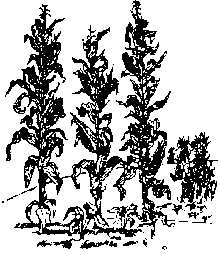The Design of Food Chains
 Recently I was visiting in a home in which a teen-ager had
received a computer game based on ecology. The idea of the
game was to design a planet in which different kinds of animals
and plants could be placed. As you created your planet's' s ecosystem,
you could add grasses, trees, bushes, and decomposers.
You could also add animals that were meat eaters, animals that
were plant eaters, insects, and insect eaters. The object of the
game was to see how long your "earth" could exist. If you put
all plant eaters on your planet, for example, your planet would very
quickly die because all the plants would get eaten up and the animals
would starve to death. If you put too many meat eaters on your planet,
it would be short time before the plant eaters would all be gone and
the meat eaters would starve to death and the plants would choke
themselves out. It was very difficult to get a balance that would allow
the planet to survive for more than a few thousand years.
Recently I was visiting in a home in which a teen-ager had
received a computer game based on ecology. The idea of the
game was to design a planet in which different kinds of animals
and plants could be placed. As you created your planet's' s ecosystem,
you could add grasses, trees, bushes, and decomposers.
You could also add animals that were meat eaters, animals that
were plant eaters, insects, and insect eaters. The object of the
game was to see how long your "earth" could exist. If you put
all plant eaters on your planet, for example, your planet would very
quickly die because all the plants would get eaten up and the animals
would starve to death. If you put too many meat eaters on your planet,
it would be short time before the plant eaters would all be gone and
the meat eaters would starve to death and the plants would choke
themselves out. It was very difficult to get a balance that would allow
the planet to survive for more than a few thousand years.
The more science learns of the balance of food chains in all
environment found in the world, the more the complexity of the
situation stands out. Recent studies in Alaska and Isle Royale, MI, for
example, have shown a huge correlation between the wolf population
and the normal vegetative pattern. It turns out that moose in Alaska
do enormous damage to the plants essential to sustain the environment
--especially some of the evergreens that support the winter
ecology during the winter months. When the wolves are killed off by
disease or hunters, the moose population explodes and the vegetation
is wiped out. The correlation between the wolf population and the
abundance of plants has now been well documented.
The ability of the natural world to survive over a long period of
time is clue to the incredibly complex and interwoven system of food
chains that sustain it. Playing the computer game where you have to
play God, even on a limited human scale, is a powerful testimony that
our world has been designed by a master intelligence.
John N. Clayton
Back to Contents Does God Exist?, January/February 1996
 Recently I was visiting in a home in which a teen-ager had
received a computer game based on ecology. The idea of the
game was to design a planet in which different kinds of animals
and plants could be placed. As you created your planet's' s ecosystem,
you could add grasses, trees, bushes, and decomposers.
You could also add animals that were meat eaters, animals that
were plant eaters, insects, and insect eaters. The object of the
game was to see how long your "earth" could exist. If you put
all plant eaters on your planet, for example, your planet would very
quickly die because all the plants would get eaten up and the animals
would starve to death. If you put too many meat eaters on your planet,
it would be short time before the plant eaters would all be gone and
the meat eaters would starve to death and the plants would choke
themselves out. It was very difficult to get a balance that would allow
the planet to survive for more than a few thousand years.
Recently I was visiting in a home in which a teen-ager had
received a computer game based on ecology. The idea of the
game was to design a planet in which different kinds of animals
and plants could be placed. As you created your planet's' s ecosystem,
you could add grasses, trees, bushes, and decomposers.
You could also add animals that were meat eaters, animals that
were plant eaters, insects, and insect eaters. The object of the
game was to see how long your "earth" could exist. If you put
all plant eaters on your planet, for example, your planet would very
quickly die because all the plants would get eaten up and the animals
would starve to death. If you put too many meat eaters on your planet,
it would be short time before the plant eaters would all be gone and
the meat eaters would starve to death and the plants would choke
themselves out. It was very difficult to get a balance that would allow
the planet to survive for more than a few thousand years.